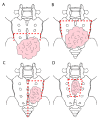Towards Standardisation of Technique for En Bloc Sacrectomy for Locally Advanced and Recurrent Rectal Cancer
- PMID: 34768442
- PMCID: PMC8584798
- DOI: 10.3390/jcm10214921
Towards Standardisation of Technique for En Bloc Sacrectomy for Locally Advanced and Recurrent Rectal Cancer
Abstract
Treatment strategies for advanced or recurrent rectal cancer have evolved such that the ultimate surgical goal to achieve a cure is complete pathological clearance. To achieve this where the sacrum is involved, en bloc sacrectomy is the current standard of care. Sacral resection is technically challenging and has been described; however, the technique has yet to be streamlined across units. This comprehensive review aims to outline the surgical approach to en bloc sacrectomy for locally advanced or recurrent rectal cancer, with standardisation of the operative steps of the procedure and to discuss options that enhance the technique.
Keywords: advanced rectal cancer; en bloc; recurrent colorectal cancer; sacrectomy.
Conflict of interest statement
The authors declare no conflict of interest.
Figures



References
Publication types
LinkOut - more resources
Full Text Sources
Research Materials

